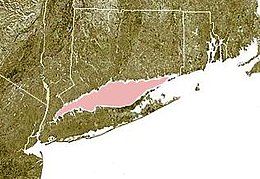Long Island Sound
A mix of freshwater from tributaries, and saltwater from the Atlantic Ocean, Long Island Sound is 21 mi (34 km) at its widest point and varies in depth from 65 to 230 feet (20 to 70 m).
Summers are hot and humid often with convective showers and strong sunshine, while the cooler months feature cold temperatures and a mix of rain and occasional snow.
Sandy plains and beaches resulted from the erosion of moraines and redeposition in these areas, and to the east of each, where the drift cover is thinnest, exposed bedrock, creating rocky headlands, often with marshlands behind them.
[5] In the rocky areas of the intertidal zone there are the seaweeds characterized by their brown tone, Fucus and Ascophyllum, some species of which have air bladders that allow them to float and receive direct sunlight even at high tide.
Much of this, enriched by decomposition, is flushed yearly into the estuary water where it directly contributes to the great finfish and shellfish production of the sound.
[5] Salt water cordgrass (Spartina alterniflora) grows along ditches and on the seaside edges of marshes where high tides daily inundate it.
Salt meadow cordgrass (Spartina patens) and spikegrass (Distichlis spicata) grow in areas less frequently inundated by saltwater, typically closer to dry land.
Frequently Atlantic bonito and false albacore, both members of the tuna family, enter the sound and can be caught by anglers from small boats and shore.
Anadromous fishes include striped bass, white perch, alewives, blueback herring, and American and hickory shad.
[11] Animals that need moist woodlands are found in the coastal area (and elsewhere), including the diamondback terrapin in salt marshes and brackish waters (and deposits and hatches its eggs on nearby sandy beaches).
There are also significant populations of red-breasted mergansers, common goldeneyes, buffleheads, white-winged scoter, American wigeon (also sometimes called baldpate), long-tailed ducks and mute swans.
As the Industrial Revolution grew, Long Island Sound began to be utilized more for manufacturing and production uses that are still observed to this day, like textiles, metal finishing, fishing, and oyster harvesting.
[19] Around the 1950s and 60s, the US Government began to recognize more of the environmental impacts pollution was having on water quality, as well as human health around regions like Long Island Sound.
[19] More habitat conservation, health monitoring, and pollution standards have been established between NY and CT in the years since to protect the estuary for future generations.
[21] Long Island Sound has historically had rich recreational and commercial fishing, including oysters, lobsters, scallops, blue crabs, tuna flounder, striped bass, and bluefish.
[23] Lobsters have suffered diseases of unknown cause, but recreational fishing improved dramatically in the last 10 years due, in large part, to restoring a key component in the food chain, menhaden (a.k.a.
[24] The ban of netting of bunker - which were over-fished in the late 1990s - has significantly improved the quality and volume of the striped bass population in Long Island Sound.
[32] The Long Island Sound ecosystem has historically been polluted by a number of different sources, including industry, agriculture and communities (untreated sewage and urban runoff).
[33][34] Eutrophication occurs when bodies of water, like Long Island Sound, are exposed to higher levels of nutrients like nitrogen, causing harmful overgrowth of cyanobacteria that feed on them.
[36] The primary target for water remediation tactics in Long Island Sound have been nutrients discharged by sewage treatment plants and in surface runoff.
The impacts listed here are directly associated with these specific species in Long Island Sound: killifishes, silversides, bay anchovy, eels, menhaden, cunner, tautog, sticklebacks, winter flounder, weakfish, bluefish, tomcod and striped bass.
Over the last several decades, excess nitrogen may have adversely affected diatoms—microscopic, single-celled algae at the base of the food chain, which make shells ('frustules') of opaline silica.
When diatoms are less productive, they are replaced by other phytoplankton such as dinoflagellates or blue-green algae, which grow well in waters with high nitrogen levels, but do not need silica.
Starting in the 1990s, Connecticut and federal United States Environmental Protection Agency (EPA) officials defined no-dumping areas in which commercial or recreational boat users were prohibited from releasing untreated sewage into the Sound near the coastline.
In 2007 state and federal officials announced the ban had extended to the entire Connecticut coast and applied to both treated and untreated sewage.
Development resulting from population increases, past industrial pollution and stormwater runoff all contribute to the poor quality of the water, according to the report.
[19] According to LISS as of 2018, significant improvements to wastewater treatment plants have led to "over 50 million fewer pounds of nitrogen a year are discharged into Long Island Sound" in comparison to the 1990s.
[44] To continue improving the quality of Long Island Sound, both ongoing challenges and adapting to new conditions due to climate change need to be addressed.
In 2007, the U.S. EPA and U.S. Army Corps of Engineers began a five- to seven-year, $16 million study on more environmentally friendly ways to dredge harbors in the Sound.
[46] Federal officials had concluded that sediment from Bridgeport Harbor was too contaminated for disposal in the Sound, and in 2007 the Connecticut Department of Environmental Protection (DEP) required Norwalk, Connecticut, to "cap" 350,000 cubic yards (270,000 m3) of dumped sediment from a planned Norwalk Harbor dredging project with 75,000 cubic yards (57,000 m3) of material.












